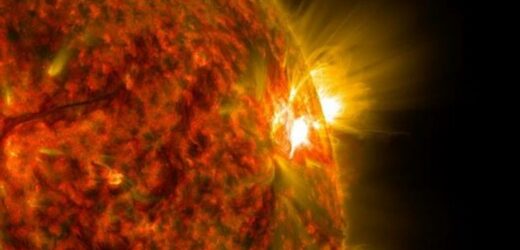NASA observatory spots flurry of solar flares
We use your sign-up to provide content in ways you’ve consented to and to improve our understanding of you. This may include adverts from us and 3rd parties based on our understanding. You can unsubscribe at any time. More info
It comes after a G2 level solar storm, caused by a Coronal Mass Ejection (CME), blasted from the Sun and hit the Earth on Tuesday morning. Solar storms are ranked from G1 to G5, highest to lowest, and even a G2 storm is said to have the potential to cause power shortages and radio outages if it comes into contact with a satellite. The higher the rank of the storm, the stronger the magnetic field it has and the larger its impact can be.
While the recent solar storm was said to be only “moderate,” Professor Mathew Owen from The University of Reading, warned that we should not rule out the chance of a G5 storm striking Earth in the future.
He told Express.co.uk: “The thing we really worry about is the power system.
“If you’ve got a really intense storm, you can get additional currents flowing in your power system and at some point, your transformers just can’t handle that anymore, so a really intense storm could burn out transformers.


“The absolute worst-case scenario is a global power outage, we’ve modelled these situations and it can happen.”
And in this devastating scenario, Professor Owens said the effects have the potential to last for weeks.
He added: “These transformers are not easy to replace so it takes a long time to get your grid up and functioning again if they collapse.
“You’d hope you could get it up and running within days but worst-case scenario is being without power for weeks.”
But some parts of the world may suffer more than others.
Prof Owens warned that high latitude countries are at the greatest risks of suffering the severest effects.

He told Express.co.uk: “The high latitudes are the most vulnerable, it’s happened in Canada in 1989 when the power went down in Quebec.”
This geomagnetic storm caused a nine-hour outage of Hydro-Quebec’s electricity transmission system.
As it happened during the Cold War it also left many terrified that a nuclear strike might be in progress.
Others incorrectly considered the intense auroras to be associated with the Space Shuttle mission STS-29.
Geomagnetic storms are caused by CME’s which produce “large expulsions of plasma and magnetic field from the Sun’s corona,” according to the National Oceanic and Atmospheric Administration (NOAA).
DON’T MISS
Cancer breakthrough as ‘amazing’ new treatment destroys tumours [REPORT]
Mystery illness outbreak: Six dead as investigation launched [REVEAL]
Solar storm: Power grid fears after NASA spacecraft rocked [INSIGHT]


NOAA said these shocking events happen when there is a period of heightened activity as a result of solar winds in the space environment surrounding Earth.
A solar storm earth can trigger a differing range of effects like power fluctuations but also can bring about differing visibility of the aurora borealis, more commonly known as the Northern Lights.
While there were fears the G2 storm would rip through satellites and cause havoc to global to communications, it also brought with it a stunning Northern Lights display.
From Canada to New York, and even to the northern parts of Scotland, lucky spectators were able to spot stunning views of the bright green phenomenon.
Source: Read Full Article


